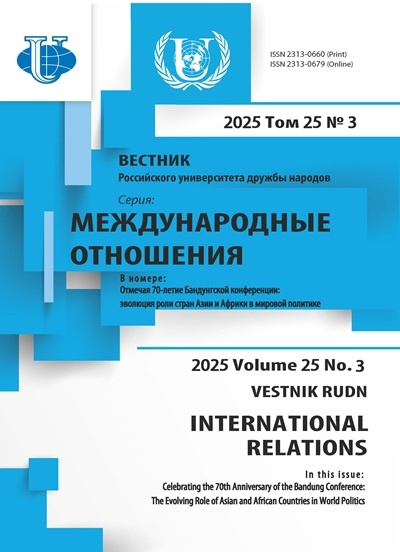Формирование образа России аналитическими центрами Германии в контексте сирийского кризиса (на примере Фонда Фридриха Эберта)
- Авторы: Ивкина Н.В.1
-
Учреждения:
- Российский университет дружбы народов
- Выпуск: Том 18, № 1 (2018): Великие державы: парадоксы восприятия
- Страницы: 96-106
- Раздел: ТЕМАТИЧЕСКОЕ ДОСЬЕ
- URL: https://journals.rudn.ru/international-relations/article/view/18379
- DOI: https://doi.org/10.22363/2313-0660-2018-18-1-96-106
- ID: 18379
Цитировать
Полный текст
Аннотация
Актуальность темы исследования обусловлена возрастающей ролью аналитических центров в формировании образа России в общественном сознании зарубежных стран. В этой связи позиция немецких аналитических центров представляет наибольший интерес. ФРГ - это государство, с одной стороны, являющееся членом военно-политического блока НАТО, политика которого может представлять определенную угрозу для национальных интересов России, а с другой - один из основных европейских партнеров России. Это не дает ей в полной мере сформировать четко очерченную позицию по проблемам, имеющим непосредственное отношение к России, а также по вопросам, в решение которых вовлечены оба государства. Целью исследования является выявление роли аналитических центров Германии в процессе формирования образа России, а также степени влияния исследований аналитических центров на средства массовой информации. В качестве основного аналитического центра, материалы которого легли в основу исследования, был выбран Фонд Фридриха Эберта. Организация имеет представительство в России. На его примере проводится исследование роли центров в формировании образа России в рамках урегулирования сирийского кризиса. В качестве методов исследования следует выделить метод описания, использовавшийся для изучения материалов Фонда, метод сравнения для выбора объекта исследования, а также для выявления влияния материалов центра на различные средства массовой информации. Для более широкого раскрытия темы помимо материалов аналитических центров были использованы некоторые источники, а также дополнительная российская и зарубежная литература и материалы статистических агентств. Результаты исследования представляют собой ряд выводов, которые показывают степень заинтересованности Фонда Фридриха Эберта в процессе формирования российского образа и перспективы реализации идей аналитического центра в немецкой новостной системе.
Ключевые слова
Об авторах
Наталья Викторовна Ивкина
Российский университет дружбы народов
Автор, ответственный за переписку.
Email: ivkina_nv@rudn.university
ассистент кафедры теории и истории международных отношений Российского университета дружбы народов
Список литературы
- Базаренко Т.В. Роль регионального аспекта международных отношений в исследованиях аналитических центров Испании // Вестник Российского университета дружбы народов. Серия: Международные отношения. 2014. № 2. C. 148-157.
- Звягина Д.А. Аналитические центры Германии: история успеха // Современные научные исследования и инновации. 2014. № 9. Ч. 2. URL: http://web.snauka.ru/issues/2014/09/37292 (дата обращения: 20.12.2017).
- Ивкина Н.В., Мараховский Е.Л. Вывод российских ВКС из Сирии: новая надежда западных СМИ. РИСИ. 2016. URL: https://riss.ru/analitycs/29188/ (дата обращения: 20.12.2017).
- Ивкина Н.В., Петрович-Белкин О.К. Взаимодействие США и Франции в области противодействия международному терроризму // Вестник Российского университета дружбы народов. Серия: Международные отношения. 2013. № 2. С. 39-46.
- Ивкина Н.В., Пойда А.А. Позиция американских «мозговых центров» по ядерной программе Ирана // Вестник Российского университета дружбы народов. Серия: Международные отношения. 2015. № 3. С. 118-125.
- Косов А.П. США и «Арабская весна»: оценки российского экспертного сообщества // Вестник Российского университета дружбы народов. Серия: Международные отношения. 2016. Т. 16. № 3. С. 473-480.
- Курылев К.П., Нгоян А.Л., Паласиос Э.К., Скудина О.В. Неурегулированные конфликты на постсоветском пространстве в анализе западных экспертно-аналитических центров // Вестник Российского университета дружбы народов. Серия: Международные отношения. 2016. Т. 16. № 3. С. 482-493.
- Петров Е.В. «Русская тема» на Западе: словарь-справочник по американскому россиеведению. СПб.: Изд-во Санкт-Петербургского им. В.Б. Бобкова филиала Российской таможенной академии, 1997.
- Шаклеина Т.А. Концептуализация политики США в отношении России в 2000-е годы // «Зарубежное россиеведение»: учеб. пособие / под ред. А.Б. Безбородова. М.: Проспект, 2015. С. 328-370.
- Abbrams E. Russia + Syria + Hezbollah = Hamas. Council on Foreign Relations. 2011. URL: https://www.cfr.org/blog/russia-syria-hezbollah-hamas (accessed: 20.12.2017).
- Dominique D. Que faire de la Russie? Que faire avec la Russie? IFRI. URL: http://www.ifri.org/ sites/default/files/atoms/files/actuelle_david_que_faire_de_la_russie.pdf (accessed: 20.12.2017).
- McGann J.G. 2016 Global go to think tank index report. University of Pennsylvania ScholarlyCommons. URL: https://repository.upenn.edu/cgi/viewcontent.cgi?article=1011&context=think_ tanks (accessed: 20.12.2017).
- Kingdon J.W. Agendas, Alternatives, and Public Policies. Boston: Longman, 2011.
- Sestanovich S. Russia’s Campaign in Syria: Three Things to Know. Council on Foreign Relations. 2015. URL: https://www.cfr.org/explainer-video/russias-campaign-syria-three-things-know (accessed: 20.12.2017).
- Wieland C. Between Democratic Hope and Centrifugal Fears. Syria’s Unexpected Open-ended Intifada. Friedrich Ebert Stiftung. 2011. URL: http://library.fes.de/pdf-files/ipg/2011-4/07_a_wieland_ eng.pdf (accessed: 20.12.2017).
Дополнительные файлы










